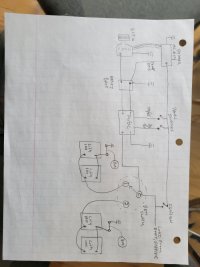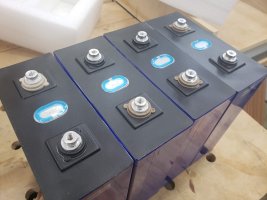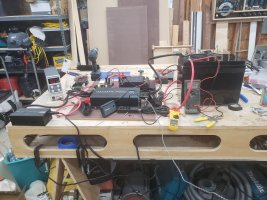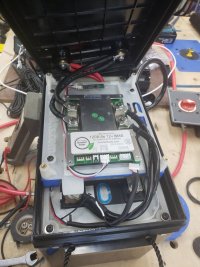I'm planning to upgrade my battery banks in the near future. Lithium seems to be an obvious choice for low lifetime cost, fast charging, and light weight.
Here is an example that appeals:
Some counter-arguments:
1. Lithium has a higher absolute purchase price cost than lead acid. (Yes, but prices are coming down all the time. $190 for an AGM 100Ah battery vs $325 for the Lithium one).
2. You'll set your boat on fire. (No, the current drop-in LifePo batteries all have integral Battery Management Systems that prevent this sort of thing).
3. You'll burn out your alternator. This seems to be a reasonable concern. The Lithium batteries will accept a lot of amperage, so without some metering function, an alternator can be burned up by the excessive draw that a Lithium battery can accept.
One answer that seems widely adopted is to use a DC-DC charger. Your alternator charges your Lead-Acid high High-Cold-Cranking-Amps starter battery, and then that starter battery is linked to your Lithium bank via a DC-DC Charger:
So the alternator is governed by the amount of amperage the lead acid battery will accept, which is the normal expectation for the alternator
Has anyone been down this path (using a DC-DC charger and a lithium bank of house batteries)?
I googled EYO forum topics and did not find much about DC DC chargers.
I know another choice is to buy a bigger, fancier externally regulated alternator (@$1,200 vs. $200 for the DC-DC charger).
I don't know much about the benefits of having a big alternator vs. simply having a DC DC charger to throttle the re-charging of the Lithium.
I suppose one tradeoff would be a longer recharging cycle?
Thanks for any ideas.
Here is an example that appeals:
Some counter-arguments:
1. Lithium has a higher absolute purchase price cost than lead acid. (Yes, but prices are coming down all the time. $190 for an AGM 100Ah battery vs $325 for the Lithium one).
2. You'll set your boat on fire. (No, the current drop-in LifePo batteries all have integral Battery Management Systems that prevent this sort of thing).
3. You'll burn out your alternator. This seems to be a reasonable concern. The Lithium batteries will accept a lot of amperage, so without some metering function, an alternator can be burned up by the excessive draw that a Lithium battery can accept.
One answer that seems widely adopted is to use a DC-DC charger. Your alternator charges your Lead-Acid high High-Cold-Cranking-Amps starter battery, and then that starter battery is linked to your Lithium bank via a DC-DC Charger:
So the alternator is governed by the amount of amperage the lead acid battery will accept, which is the normal expectation for the alternator
Has anyone been down this path (using a DC-DC charger and a lithium bank of house batteries)?
I googled EYO forum topics and did not find much about DC DC chargers.
I know another choice is to buy a bigger, fancier externally regulated alternator (@$1,200 vs. $200 for the DC-DC charger).
I don't know much about the benefits of having a big alternator vs. simply having a DC DC charger to throttle the re-charging of the Lithium.
I suppose one tradeoff would be a longer recharging cycle?
Thanks for any ideas.





